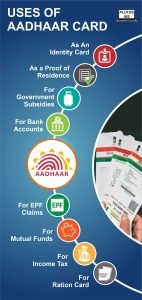03 Oct Aadhaar
This article covers “Daily Current Affairs” and the topic details “Aadhaar”. This topic has relevance in the Governance section of the UPSC CSE exam.
For Prelims:
About Aadhaar?
For Mains:
GS 2: Governance
Concerns Regarding the Use of Aadhaar?
Why in the news?
The international credit rating agency Moody’s Investor Service has published a report titled ‘Decentralised Finance and Digital Assets,’ wherein it supports adopting decentralized digital identity systems over centralized biometric systems such as India’s Aadhaar.
Rationale for Aadhaar:
- Aadhaar is a distinctive identification number issued to every Indian resident by the Unique Identification Authority of India (UIDAI).
- During the Aadhaar enrollment process, individuals’ demographic information is collected, complemented by biometric data such as fingerprints and iris scans, recognized as unique identifiers for each person.
- These particulars are securely stored within the Aadhaar database.
- The primary goals of UIDAI were to ensure that every resident possesses a one-of-a-kind identification and to combat corruption by eradicating the presence of “ghost” and “fake” individuals in welfare programs.
- The government advocates for Aadhaar in numerous other citizen-oriented cash transfer initiatives.
- By eradicating non-existent and duplicate beneficiaries, the government asserts that Aadhaar has led to significant cost savings in various welfare schemes.
Aadhaar’s Role in Cash Withdrawals:
- The process of facilitating payments through Aadhaar for schemes like MGNREGA involves a series of steps.
- First, it requires linking a worker’s Aadhaar number with their job card.
- Second, the individual’s Aadhaar must be linked to their bank account.
- Third, the correct linkage of the Aadhaar number with the bank account should be established through their bank branch, which coordinates with the National Payments Corporation of India (NPCI), serving as the intermediary for Aadhaar-based transactions.
- Aadhaar essentially serves as the financial address for individuals, and government-disbursed funds are deposited into their most recently linked Aadhaar-linked bank account.
- To access these funds, individuals can withdraw money from their Aadhaar-linked bank accounts through private banking kiosks or private banking correspondents. These transactions involve biometric authentication.
- This system is commonly referred to as the Aadhaar-enabled Payment System (AePS).

Concerns Regarding the Use of Aadhaar:
- Quantity Fraud:
- Common form of corruption, especially in ration distribution.
- Dealers provide less than the entitled quantity (e.g., 30 kg instead of 35 kg).
- Aadhaar does not detect or prevent this fraud.
- Authentication Challenges:
- People in rural areas often make multiple trips to ration shops for authentication.
- No guarantee of successful authentication.
- Infrastructure Limitations:
- Lack of reliable internet connectivity.
- Fading fingerprints among daily wage workers.
- Inadequate phone connectivity for OTPs.
- Lack of Transparency:
- Lack of public data on authentication attempts and failures.
- UIDAI lacks a system to analyze factors behind authentication errors (CAG report, 2022).
- Recurring Payment Failures:
- Errors in Aadhaar-based payments lead to payment failures.
- Discrepancies in spellings between job cards and Aadhaar databases cause authentication failures.
- Workers often unaware of the last account their Aadhaar was linked to.
- Coercive Aadhaar linking without consent diverts wages.
- Security Concerns:
-
- Banking correspondents in Aadhaar-enabled Payment System (AePS) operate without accountability.
- Multiple biometric authentications grant access to bank accounts.
- Cases of money withdrawal and unauthorized enrollment in government programs.
- Example: ₹10 crore scholarship scam in Jharkhand (2020).
|
The Unique Identification Authority of India (UIDAI):
|
Download plutus ias current affairs eng med 3rd Oct 2023 pdf
Q.1 Consider the following statements regarding Aadhaar-enabled Payment System (AePS):
- AePS allows cash withdrawals through private banking kiosks and correspondents.
- It requires the input of OTPs and bank account details for transactions.
- AePS is a bank-led model allowing online interoperable financial transactions at Point of Sale (PoS)
How many of the above statement/s is/are correct?
(a) Only one
(b) Only two
(c) All three
(d) None
Q.2 With reference to the Unique Identification Authority of India (UIDAI), consider the following statements:
- UIDAI operates under the Ministry of Electronics and Information Technology.
- UIDAI’s mandate includes providing a 10-digit unique identification
Which of the statements given above is/are correct?
(a) 1 only
(b) 2 only
(c) Both 1 and 2
(d) Neither 1 nor 2
Q.3 Discuss the security concerns associated with the Aadhaar system in India. What measures can be taken to enhance the security and integrity of the Aadhaar system while ensuring the benefits of its implementation?



No Comments